Is it possible to insulate a house with polyurethane foam?
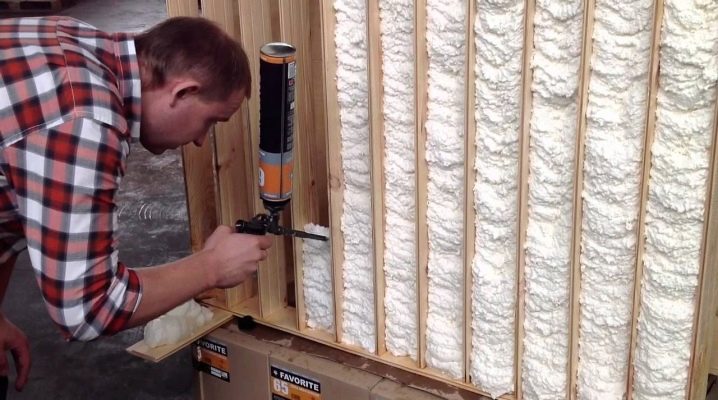
Before talking about polyurethane foam as a means of insulating a house, you need to figure out what this material is and why it is actually needed.
Features and characteristics
Polyurethane foam, also known as polyurethane foam sealant, is a substance widely used in construction to bond separate parts of the structure to be joined together, heat and sound insulation, seal and fill voids that arise during operation. Usually sold in metal cans, in which the foam itself and a mixture of liquefied gases are under pressure - the so-called. a propellant that acts as a buoyant force for the contents of the cartridge. The versatility of this synthetic polymer makes it an indispensable assistant in many types of construction work and in almost any repair.
Of course, polyurethane foam sealant has its own characteristics and characteristics, which will be discussed below.

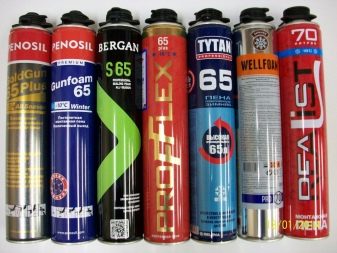
Dignity
The indisputable advantages of the substance in question, which the manufacturer usually indicates on the packaging, include:
- high degree of adhesion - that is, its ability to firmly adhere to many surfaces. Exceptions are Teflon, silicone, ice, polyethylene and oily surfaces;
- heat resistance (as a rule, it is in the range from -45 ° C to +90 ° C);
- cured polyurethane foam is a dielectric (does not conduct electric current);
- fairly fast solidification rate - from eight minutes to a day;

- high moisture resistance;
- lack of toxicity (of course, after the final solidification);
- a small percentage of shrinkage (no more than 5%) throughout the entire period of operation;
- chemical resistance;
- high strength;
- long service life of the material (up to half a century).
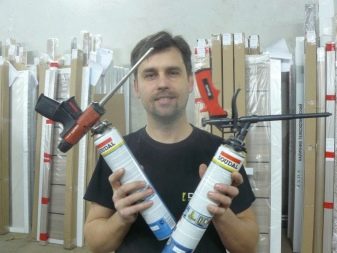
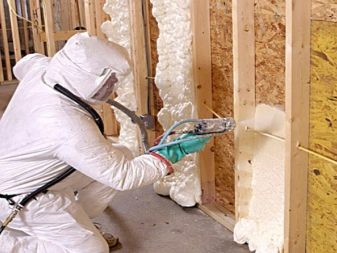
Also equally important characteristics are:
- The total volume of sealant output is calculated in liters and means the amount of foam coming out of a unit of capacity. This characteristic is influenced by the ambient temperature, the degree of humidity and windiness.
- Viscosity - mostly depends on the air temperature. Temperatures above (or below) certain limits specified for each type of foam negatively affect the viscosity of the substance. This is bad for masonry.
- Primary and secondary expansion. Primary expansion is the ability of the composition to expand immediately after leaving the container in a very short time interval (up to sixty seconds). During this short period of time, polyurethane foam sealant is able to increase in volume by 20-40 times. Secondary expansion refers to the ability of a synthetic polymer to expand for a long time before the final cessation of polymerization.
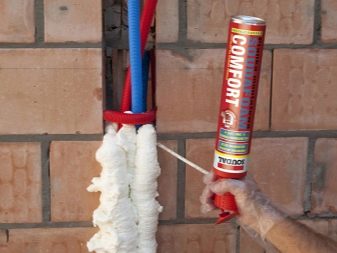
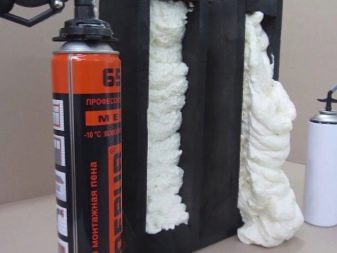
High-quality polyurethane foam has a pleasant light yellow or slightly greenish color, it does not flow down when applied to the surface and is even suitable for roofs. It is not eaten by rodents and insects, it does not harm the environment. When solidified, the substance turns into a durable porous seamless material that is quite moisture resistant and has excellent insulating properties. Polyurethane foam sealant is chemically inert, which is both its advantage and disadvantage.After it hardens, it is not subject to the destructive action of solvents, so its excess will have to be removed mechanically - using a scraper or pumice.

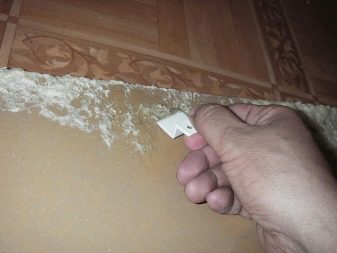
It is important to note that under the influence of solar ultraviolet radiation, this insulating material is subject to rapid destruction - at first it darkens and then becomes brittle. Never forget to plaster the foam-filled area after it has set. Otherwise, it can simply turn into dust.
Polyurethane foam is suitable for insulating a frame house. It will serve as a special air gap.
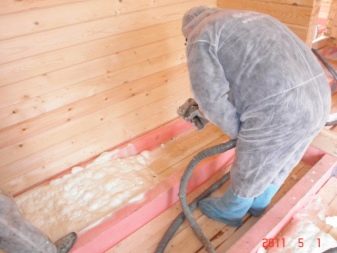

Views
It's no secret that modern insulation manufacturers offer the widest range of sealants to choose from. Let's together try to understand the abundance of types of polyurethane foam and see which types of the required substance will best serve a particular purpose.
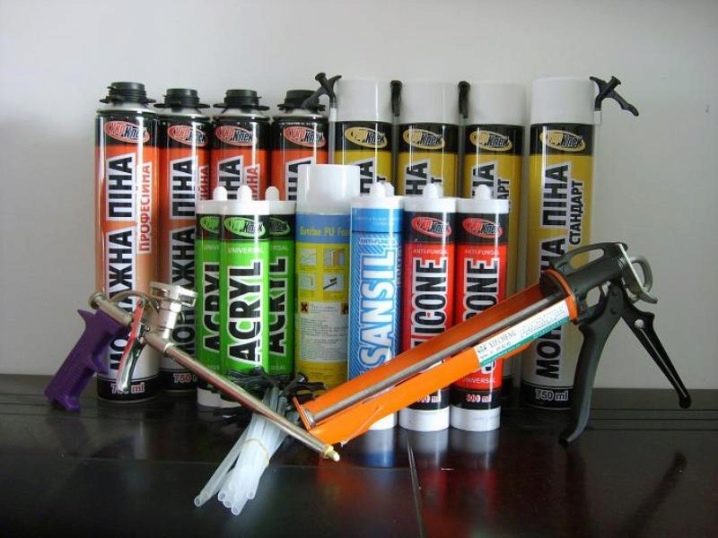
Polyurethane foam differs in several ways.
Type
Household
Pros: no special equipment is required to work with household foam. It can be easily distinguished from a professional one by its external type: there is a special valve at the end of the container, on which a lever with a plastic tube is fixed.
Cons: it can only be used to fill small voids or cracks, it is not used for installation, since it almost always requires cutting - the volume of this type of sealant is usually higher than the volume of the space it fills.
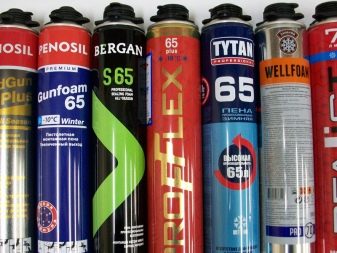
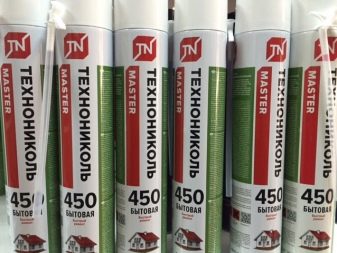
Professional
Pros: higher than the previous type, the coefficient of primary expansion, increased elasticity and finer structure. The material flow can be controlled, so it lays down more accurately than household material, evenly filling the required volume. It should also be mentioned that professional polyurethane foam can be easily attached to almost any surface.
Cons: A mounting gun is required to work with a professional look. However, given the versatility and wide scope of application, this disadvantage is very relative.
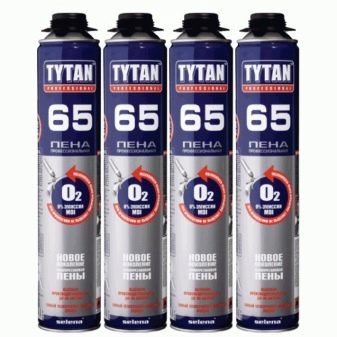
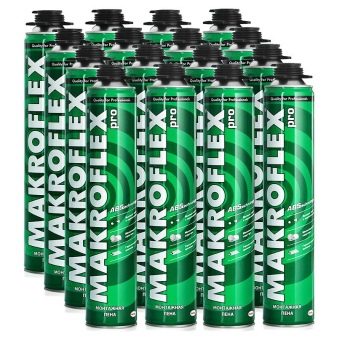
By temperature of use
Summer
Summer polyurethane foam is recommended for use at positive temperatures - from about +5 to +30. At low ambient temperatures, the release of the useful substance from the cartridge decreases, and the degree of expansion drops significantly. Work at elevated temperatures should also not be carried out due to the peculiarities of the prepolymer, whose viscosity in such cases is significantly reduced.
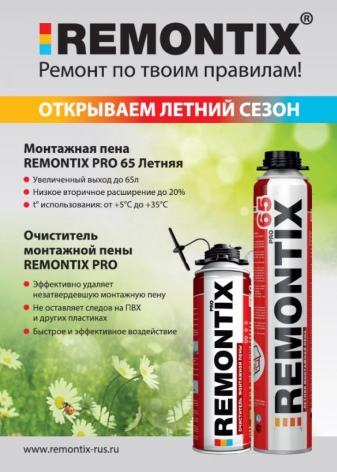
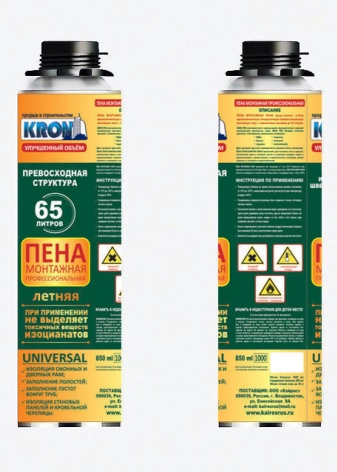
Winter
It is usually used at temperatures from -10 to +40 degrees. However, there are some types of foam that allow you to work even at -20 - for example, Tytan Professional 65 sealant. After hardening, the winter type is able to easily withstand seventy-degree frost. Suitable for a barrel in which any substance can be stored.
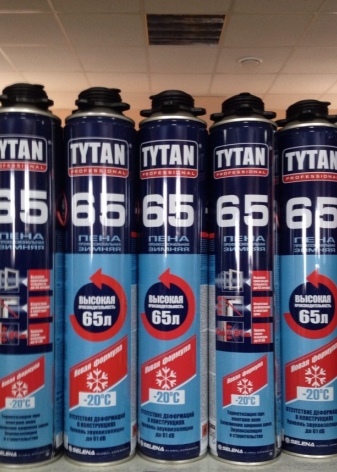

All-season (or universal)
In fact, it has almost the same temperature range as the winter one and does not always stand out as a separate group. Work with it is carried out at temperatures from -15 to +30 degrees.

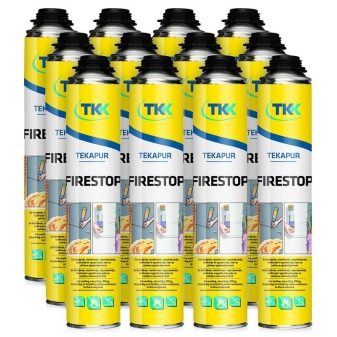
By the number of components in the can
One-component
It is quite widespread and has a relatively low cost. The polymerization reaction takes place with water. The shelf life does not exceed one year.
Pros: low cost, ready to use immediately after purchase, easy to use.
Minuses: short shelf life.

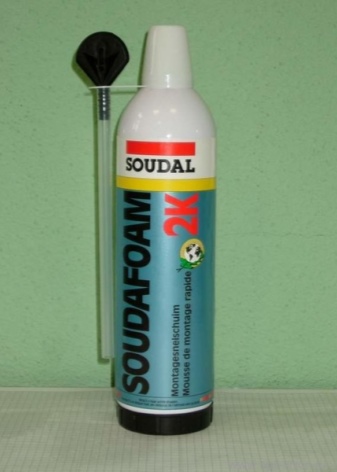
Two-component (structural)
Water does not take part in the reaction. It is replaced by a special component, which is located in a small hermetically sealed container inside the cylinder itself. Its cost is higher than that of a single-component one and, as a rule, it is sold in small containers (usually 220 ml), because the solidification period of the substance after mixing the components is short and is ten minutes.
Pros: neat filling of voids.
Minuses: high cost, in the manufacture of a polyurethane mixture, it is necessary to strictly adhere to the established proportions.


By the degree of flammability
- Class B1 - fireproof and fireproof. Usually it is pink or bright red - dyes are added on purpose so that when applied, the type of composition is immediately visible.
- Class B2 - self-extinguishing, as the name implies, it does not support combustion.
- Class B3 - combustible polyurethane foam with zero refractoriness. The reviews are mostly positive.


Insulation technology
There are several principles of insulation with a do-it-yourself sealant. Let's highlight two basic principles and consider them in detail:
- The first and most common technology of insulation, produced with the participation of polyurethane foam, is sputtering... As the name implies, this is the process of distributing polyurethane foam over the surface using a spray gun. The sealant instantly connects to the base on which it is applied, creating an even layer that covers the area to be insulated. This allows you to quickly insulate and, importantly, does not require leveling the walls before spraying. The rest of the material is simply cut off.
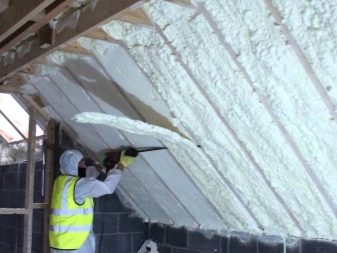
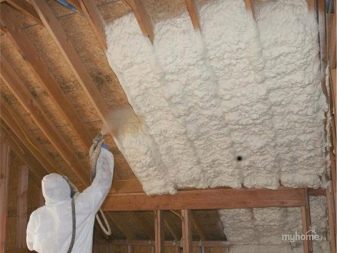
- Filling... This technology is most often used in the construction process, when the structure of the building being erected provides for voids that must be filled with an insulating substance. However, the application of this principle of insulation is also possible with a fully erected structure, however, in this case, it is necessary to have technological holes through which the foam will be supplied, as well as equipment for its injection. There is a fairly complex drilling. Using the infill method is dangerous for buildings built with poor quality materials - after all, the sealant, expanding, can harm the walls. A significant advantage of filling is the absence of the need for external finishing.
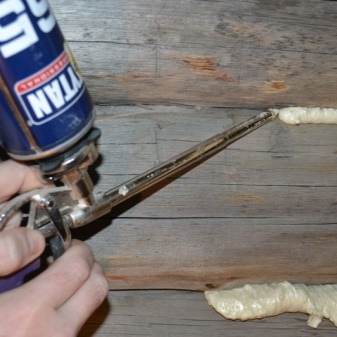
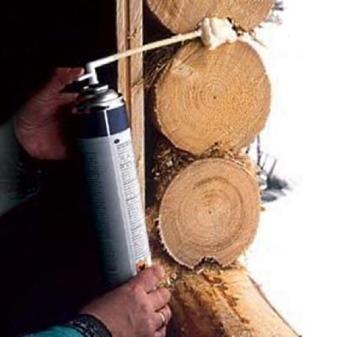
Stages of work
Before starting to work with this insulating substance, it is necessary to put on work clothes, gloves and protect the respiratory organs - for example, with a respirator, and eyes - with transparent plastic goggles. It is not recommended to allow prolonged contact of the liquid substance with the skin - it can cause serious irritation. If the sealant gets on unprotected areas of the skin, it is advisable to wash it off with water and soap as soon as possible.
Then you should prepare the surface for the application of insulating material, after removing dust and dirt from it. It is preferable to carry out wet cleaning, because polyurethane foam will adhere much better to a damp surface. If the composition must fill the space between the pipes, then they can be wrapped with oilcloth so as not to get dirty.

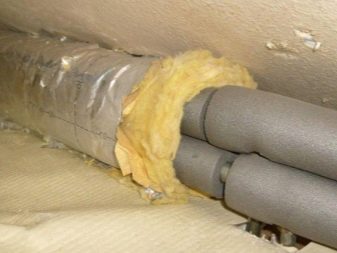
After the preparatory stage, you can start, in fact, the insulation.
If you use the spray technology, then the polyurethane foam must be applied from the bottom up, paying special attention to the corners and joints of the surfaces, so as not to leave unfilled areas. To achieve a certain thickness of insulation, you can safely apply several layers on top of each other.

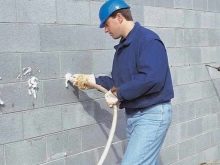
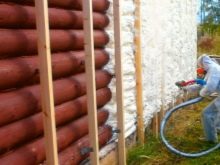
If the method you have chosen is filling, then it is recommended to pour the foam in portions from top to bottom, relying on the fact that the sealant itself will be distributed inside the filled volume and evenly fill it. Unfortunately, when using this technology, you will not be able to follow the uniform filling of the left voids. After pouring, it will be advisable to remove streaks that may appear - they look rather unaesthetic. Technological holes, through which the sealant got into the space it fills, is best not to leave open. It is desirable to close them up.
After the final hardening / hardening of the polyurethane foam, we can safely assume that the insulation has taken place.True, do not forget that in order to avoid decomposition and decrease in the strength of the substance, the insulated surface must be protected from direct sunlight. This can be done with paint, plaster, putty. You can also sheathe the treated surface with something, for example, drywall or other dense material.


Where can you use it?
It is possible to insulate with polyurethane foam both residential or industrial buildings (inside or outside) and window or doorways, as well as fill the voids formed in the walls when laying communications and pipes. The miracle sealant easily fills even small gaps, preventing insidious drafts from occurring. Walls, floors and ceilings are easily insulated. It protects the tree from rotting and fungal mold. Iron - against corrosion.

The ecological purity of the sealant allows it to be used even in such a case as warming a nursery. Therefore, if we return to the topic of our article: “Is it possible to insulate a house with polyurethane foam? "- the answer will be definite. It is possible and even necessary! Of course, the high price of polyurethane foam sealant may scare away, but the advantages voiced above will definitely be worth the funds that you will spend on insulating your home. True, one should not forget about one nuance - the use of an insulating material of this type makes the insulated room almost airtight, which means that the building or room must have well-thought-out ventilation so that there are no problems with stuffiness or stale air.
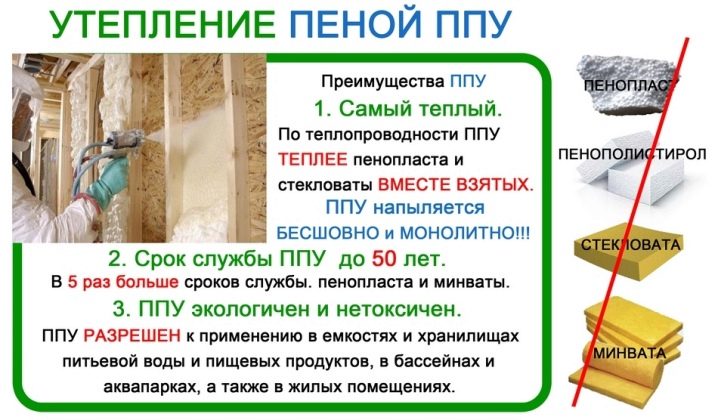
The mounting foam is suitable for insulating hangars, garage doors, garages, facades, windows, as well as balconies and baths. With the help of the material, you can insulate the area of the inter-wall space between the brick and the block. Waterproofing with it from the inside and on the roof is more reliable.
For information on how to insulate a balcony with polyurethane foam, see the next video.













Mice chew on foam.
The comment was sent successfully.